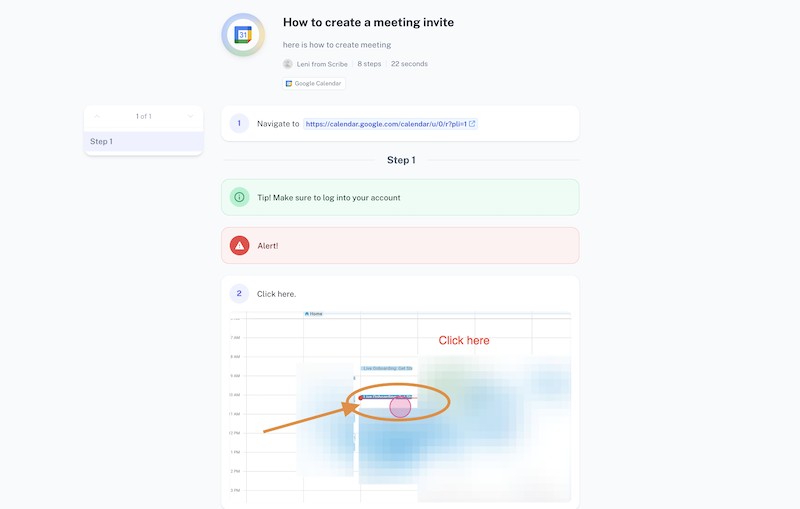A “how-to” guide, or step-by-step guide, typically provides instructions on how to do something. However, the effectiveness of these guides varies greatly. This article provides a comprehensive overview of how to create an effective how-to guide, with valuable How To Guide Examples, templates, and tips.
What is a How-to Guide?
A how-to guide explains a process from start to finish, providing step-by-step instructions, often accompanied by visuals like images and examples for clarity.
How-to guides serve various purposes for businesses:
- Creating work instructions for team members.
- Sharing product or service information.
- Improving search engine visibility for marketing purposes.
- Providing user manuals for enhanced customer experience.
How-to Guide Format: Structuring Your Guide
While the creation and distribution of how to guide examples may vary depending on the objective, most follow a similar structure:
- Clear Title: A concise and descriptive title that accurately reflects the guide’s purpose.
- Brief Overview: An introduction to the topic.
- Logical Steps: A well-organized, step-by-step list.
- Visuals: Helpful images and videos alongside each step.
- Desired Result: Clearly state the outcome.
- Additional Tips: Supplemental resources and advice.
Here’s another effective how to guide example, showcasing a clear title, concise summary, logical steps, and helpful screenshots:
Why Create a How-to Guide?
Creating and sharing how-to guides offers various benefits.
1. Quickly Answer Common Questions
How-to guides provide readily available, informative answers to frequently asked questions, saving time and ensuring consistent information is shared. Regularly update guides based on feedback to maintain relevance.
2. Streamline Employee Onboarding and Training
How-to guides provide new hires with the necessary steps to perform their jobs effectively, expanding their knowledge, and boosting productivity. Combine guides into training manuals.
3. Boost Customer Satisfaction
Provide a comprehensive help center or FAQ page with helpful how to guide examples to empower customers to troubleshoot issues independently, reducing support tickets.
4. Enhance Content Marketing
“How to” searches are extremely popular. Guides are valuable for attracting leads, raising product awareness, and establishing authority.
Here’s a content marketing strategy using how to guide examples:
- Identify user questions on forums.
- Create a content calendar for relevant blog posts.
- Research the topic thoroughly.
- Select a focus keyword for each article and use internal links.
- Provide clear instructions with visuals.
- Optimize each post for search engines.
- Publish the guide.
How to Create a How-To Guide: Step-by-Step
Here’s a step-by-step process for crafting effective how to guide examples:
1. Define Your Target Audience
Identify the intended audience and tailor the guide to their knowledge level, language, and needs. Analyze user data, support tickets, and online forums to gain insights.
2. Conduct Thorough Research
Ensure the guide solves the reader’s problem with up-to-date information and helpful visuals. Cite reliable external sources.
3. Draft Your How-to Guide
Create a clear outline, add a summary, use logical steps, and incorporate relevant visuals like annotated screenshots. For longer procedures, include a table of contents.
4. Review and Refine
Thoroughly review the content for accuracy, clarity, and potential errors. Test the steps to ensure the desired outcome.
5. Distribute Your Guide
Share the guide with employees via a knowledge base or documentation tool. For customers, integrate it into the help center or FAQ page. In content marketing, optimize it with relevant keywords and visuals for search engine visibility.
6. Gather and Integrate Feedback
Establish a feedback loop to keep the guide updated and relevant. Utilize tools with built-in feedback features.
How to Guide Examples: Different Types for Different Needs
Various types of how to guide examples can be used based on your particular requirements.
1. Standard How-to Guide
This simple document clarifies the purpose of the guide, its creator, the number of steps involved, and includes user reactions.
2. Recipe How-to Guide
This type of guide quickly informs readers about the required time, ingredients, skill level, and steps to make the dish successfully.
3. B2B How-to Guide
This guide provides essential background information, answers frequently asked questions, and offers downloadable resources like PDFs.
4. B2C How-to Guide
This guide employs a conversational style, avoids technical jargon, and uses pagination to link to relevant articles.
5. Product-Related How-to Guide
With a user-friendly interface and clear language, it adopts a neutral tone and provides comprehensive documentation with customer support access.
6. Lifestyle How-to Guide
This guide provides information that is both succinct and helpful regarding how to live a healthy life in the form of numbered lists, so it’s easy to relate how-to guide topics with each other.
How-to Guide Template and Guide Creator
There are several solutions available to assist in the creation of visual how to guide examples.
How-to Guide Template
The free template includes an introduction, overview, list of materials, troubleshooting section, and conclusion.
How-to Guide Creator
This tool automatically generates visual how-to guides in seconds by capturing a user’s actions and creating step-by-step instructions with annotated screenshots.
Common How-to Guide Challenges
When crafting how to guide examples, avoid these common pitfalls.
1. Not Publishing the Guide
Ensure the guide is accessible to the target audience through a knowledge base or blog.
2. Not Tailoring to the Audience
Provide relevant information and avoid unnecessary details.
3. Lacking Expertise
Ensure the guide is written by someone knowledgeable about the task.
4. Over-relying on Paid Ads
Focus on SEO to achieve sustainable organic traffic.
5. Insufficient Visuals
Break up text with screenshots, tables, and other visuals.
In Conclusion: Create Effective How-to Guides
By identifying the audience, choosing the right tools, and following these guidelines, you can create how to guide examples that provide real solutions and demonstrate authority.
